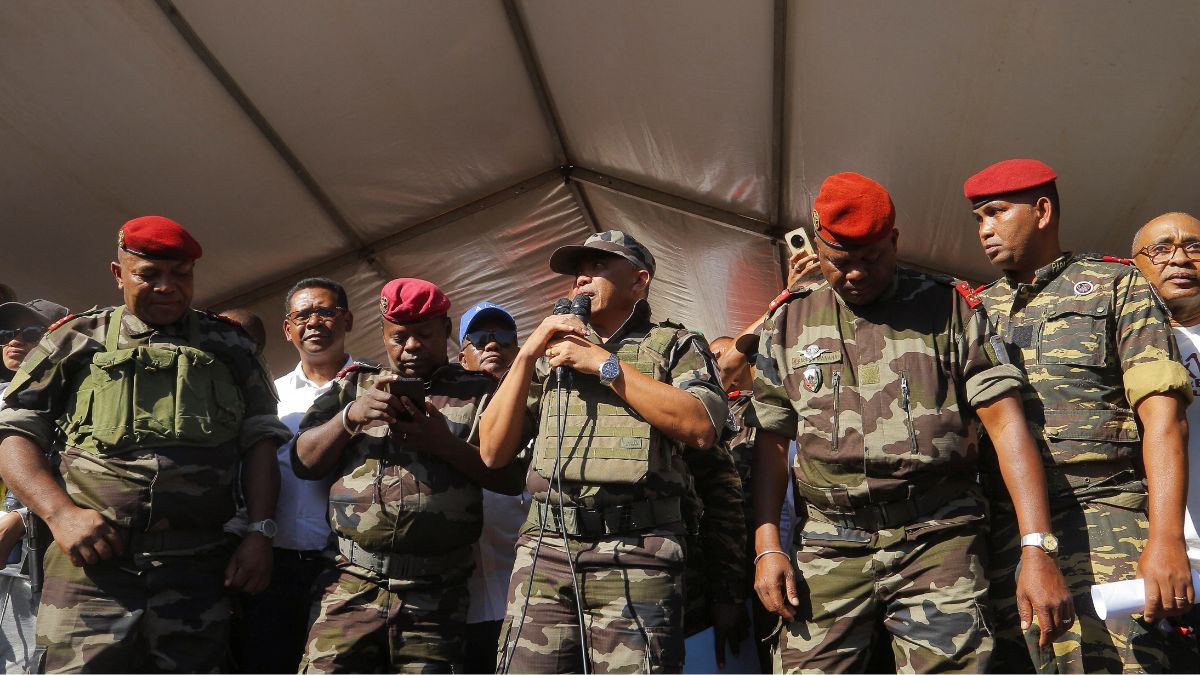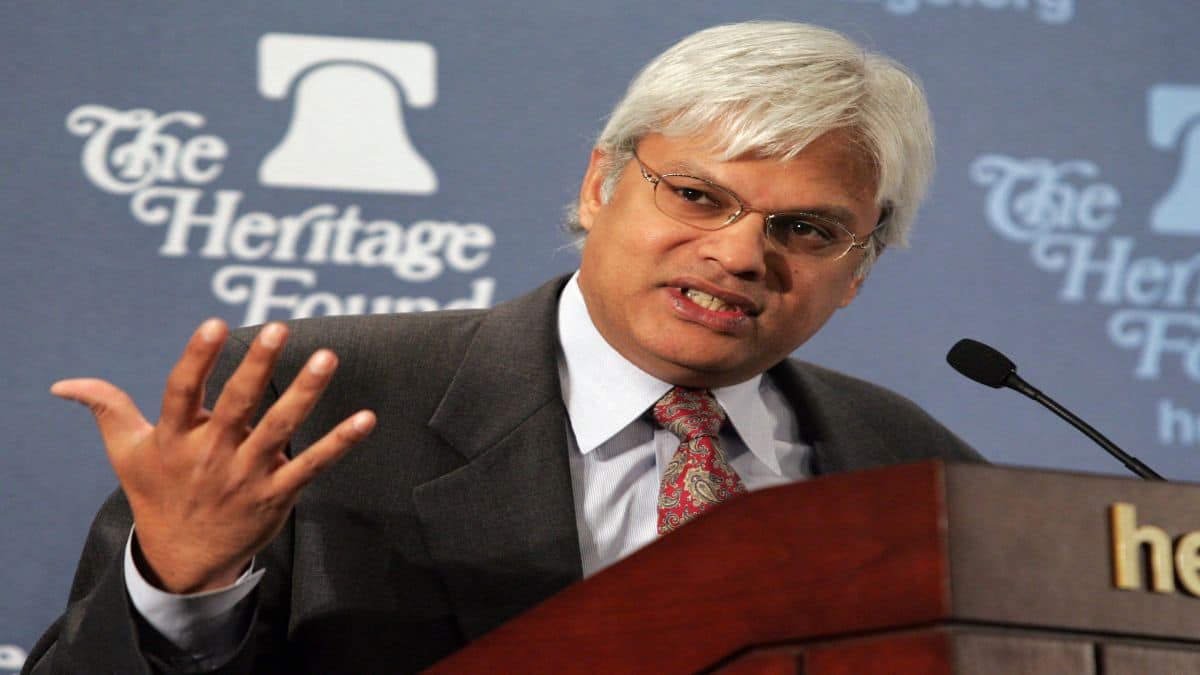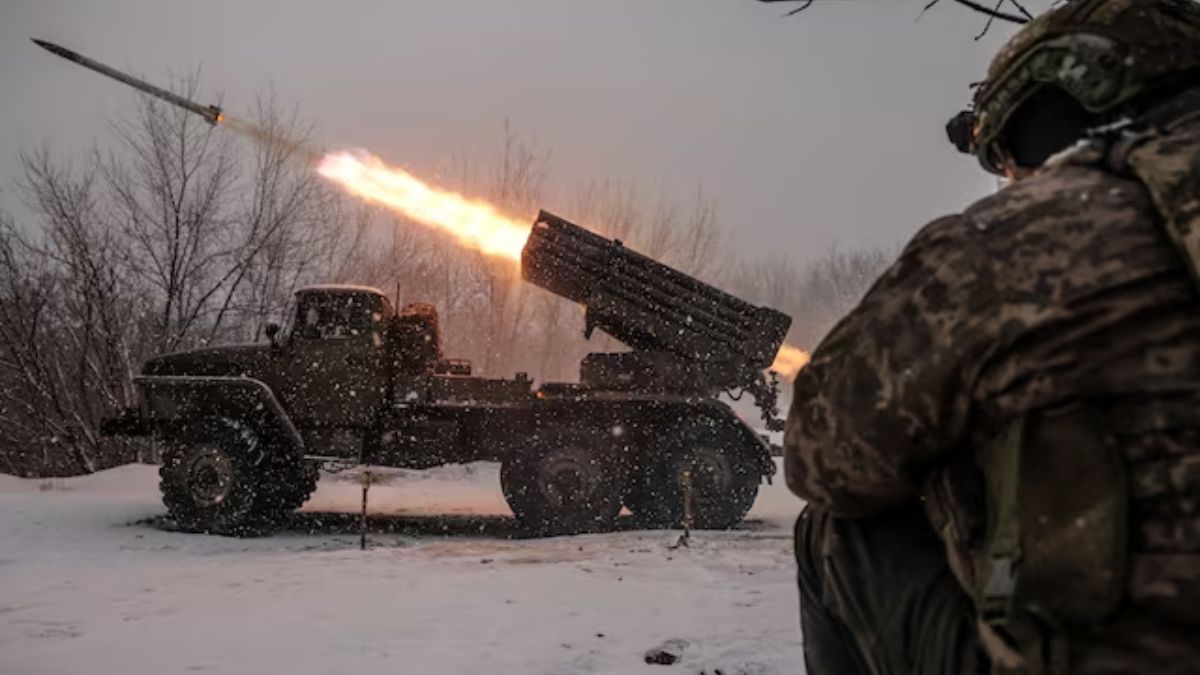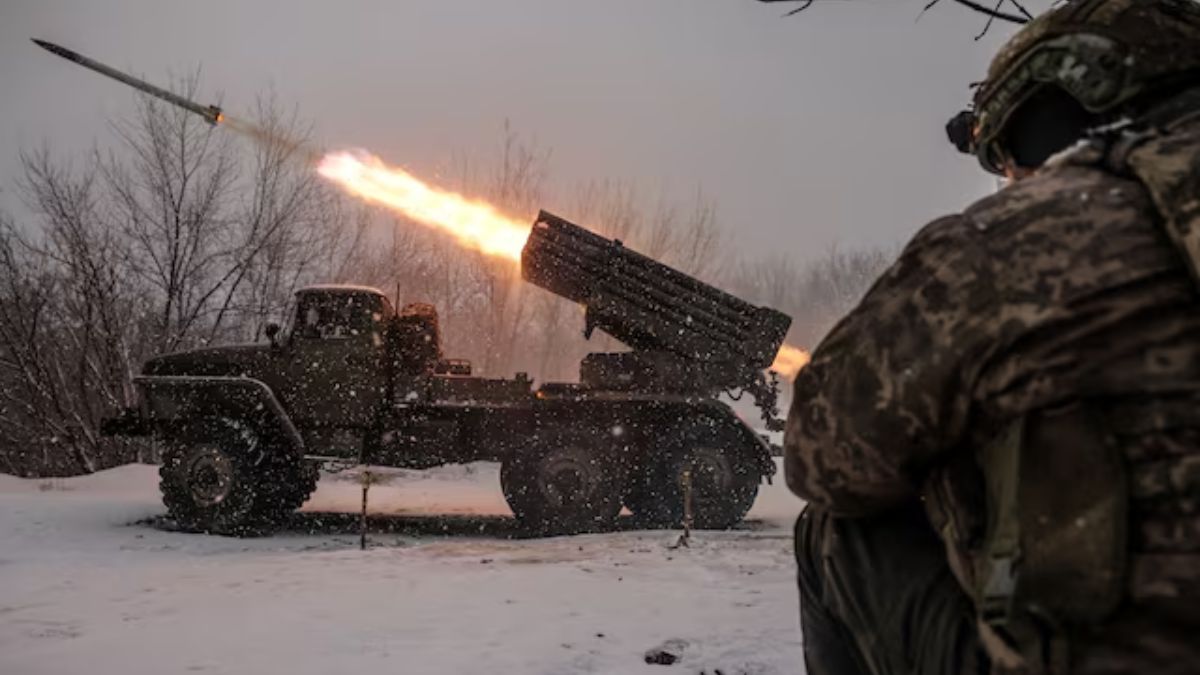On Tuesday, October 14, 2025, Colonel Michael Randrianirina, the head of the elite CAPSAT military unit, announced that the army had taken charge following the impeachment of President Andry Rajoelina by lawmakers and his subsequent flight from Madagascar.
Speaking on national radio, Randrianirina declared, “We have taken the power,” and confirmed that the military would assume control of state affairs.
He added that most of the country’s key institutions had been suspended, except for the National Assembly, which had earlier voted to remove Rajoelina from office.
The military’s statement specified that “The following institutions are suspended: the Senate, the High Constitutional Court, the Independent National Electoral Commission, the High Court of Justice, and the High Council for the Defense of Human Rights and the Rule of Law.”
The colonel further announced that a temporary ruling committee would govern Madagascar for a period not exceeding two years, during which a civilian transitional administration would be formed and preparations made for new elections.
“At the same time, after a few days, we will set up a civilian government,” he said, according to AFP.
The announcement followed weeks of youth-led demonstrations that swept across Antananarivo and other cities, with protesters calling for Rajoelina’s resignation over corruption, deteriorating living standards, and government inefficiency.
The protests, initially triggered by persistent water and power shortages, rapidly expanded into a broader political movement fuelled by disillusionment among the country’s younger population — most of whom have known little beyond recurring political instability since birth.
How did protests turn into a military takeover?
By late September, rallies had become daily events in the capital’s central 13 May Square, a symbol of political mobilisation since Madagascar’s independence.
The area, flanked by palm-lined boulevards and remnants of French colonial architecture, filled with thousands of demonstrators waving the Malagasy flag and banners featuring the skull and crossbones symbol from the Japanese anime One Piece — a motif that had become emblematic of the Gen Z protests.
On October 13, the situation reached a boiling point.
Members of the CAPSAT unit joined protesters in the streets, refusing to obey orders to suppress the demonstrations. Their defection was decisive.
When Colonel Randrianirina addressed the crowd, he asked, “Are you ready to accept a military takeover?” The square erupted in cheers.
CAPSAT’s public defiance prompted further fractures within the security establishment. Within days, the paramilitary gendarmerie and sections of the national police also withdrew their support from Rajoelina.
On Sunday, the president warned that “an attempted coup” was under way. But the warning came too late.
According to multiple sources — including opposition figures, diplomats, and military insiders — Rajoelina fled Madagascar aboard a French military aircraft, departing the Indian Ocean island nation he had ruled since 2009.
The former DJ-turned-politician, who once benefitted from a similar military defection that toppled his predecessor, now found himself ousted under near-identical circumstances.
In his final televised address, Rajoelina said he had been forced into hiding due to threats to his life.
His political isolation deepened when legislators from his own coalition, which held a parliamentary majority, voted to impeach him on charges of violating the constitution and engaging in actions “incompatible with presidential duties.”
The resulting constitutional vacuum allowed the army to assert control, framing its intervention as a measure to restore order and prevent chaos.
What is CAPSAT: the elite unit behind the mutiny?
The Corps d’administration des personnels et des services administratifs et techniques — known by its acronym CAPSAT — is one of the most powerful branches of Madagascar’s armed forces.
Based in the Soanierana district on the outskirts of Antananarivo, it is not a front-line combat unit but plays a central role in the management of military logistics, technical operations, and personnel administration.
Despite its technical mandate, CAPSAT wields outsized influence within the armed forces and the political establishment.
Historically, it has maintained strong ties with Madagascar’s elite, including business circles and sections of the gendarmerie.
Analysts note that CAPSAT’s structural control over key army functions effectively gives it the ability to paralyse or steer the military’s overall operations — a factor that has made it decisive in moments of political transition.
This was most evident in 2009, when CAPSAT’s defection from then-President Marc Ravalomanana’s government facilitated his downfall and paved the way for a young Andry Rajoelina, then the mayor of Antananarivo, to seize power.
That episode established CAPSAT’s reputation as a “kingmaker” within Madagascar’s volatile political system.
Political analyst Rose Mumanya observed that the echoes of 2009 were unmistakable. “Because of the influence, the history and the legitimacy that CAPSAT has, it means that, as much as Rajoelina has leverage and control of other units, the balance of power is not in his favour right now,” she told DW.
She added that although Rajoelina had sought to embed loyalists across other branches of the military to avoid a repeat of the 2009 events, CAPSAT’s independence and institutional weight made it uniquely capable of challenging his authority.
How did CAPSAT turn against Rajoelina?
The unit’s open defiance of the government began on Saturday, October 11, when its members marched into Antananarivo and joined protesters calling for Rajoelina’s ouster.
Eyewitnesses reported scenes of soldiers packed into trucks waving the national flag and saluting demonstrators. There were also reports of armed skirmishes between CAPSAT and forces still loyal to the president, leaving at least one CAPSAT member dead.
Later that day, the unit’s spokesperson issued a statement declaring that “from now on, all orders of the Malagasy army, whether land, air, or navy, will originate from CAPSAT headquarters.”
The message called on all branches of the security apparatus to reject “orders to shoot” civilians and to side with the population.
Within hours, CAPSAT appointed a new Chief of Defence Staff, General Demosthene Pikulas, at a ceremony attended by the Armed Forces Minister Manantsoa Deramasinjaka Rakotoarivelo, who publicly endorsed the decision, saying, “I give him my blessing.”
Despite the rapidly unfolding events, Randrianirina initially rejected claims that the unit was orchestrating a coup.
“We answered the people’s calls, but it wasn’t a coup d’état,” he told reporters the following day, as thousands gathered outside Antananarivo’s city hall to pray for victims of the clashes.
The takeover nonetheless bore all the hallmarks of a military intervention. Analysts noted that CAPSAT leaders were careful to present their actions as a response to public demand rather than a power grab, in a bid to avert the kind of international condemnation that followed the 2009 coup.
Who is Colonel Michael Randrianirina?
Colonel Michael (also spelt Mickaël) Randrianirina has now emerged as the most powerful figure in Madagascar.
Born in Sevohipoty, a village located in the Androy region of southern Madagascar, he has served in various administrative and military posts over the past two decades.
Between 2016 and 2018, he was head of the Androy region under President Hery Rajaonarimampianina. Later, he commanded an army corps in Toliara before assuming leadership of CAPSAT in 2022.
His career, however, has not been without controversy. In November 2023, he was arrested and charged with “instigating a military mutiny and attempting a coup d’état” but was later released.
His reputation as an officer who often clashed with political authorities grew from that point.
During the current protests, Randrianirina became a prominent figure after publicly urging soldiers “to refuse to repress the population, to take responsibility, and to play their part.”
His appeal resonated with younger soldiers disillusioned by political interference in the army. When Rajoelina fled, CAPSAT forces swiftly occupied the presidential palace, announcing Randrianirina as interim president.
His appointment was later recognised by the National Assembly, although Rajoelina denounced the move as unconstitutional.
How have CAPSAT justified their intervention?
As head of state, Colonel Randrianirina pledged to oversee a two-year transition period before new elections.
The army has said it will form a governing committee comprising representatives from the armed forces, police, and gendarmerie, which will supervise the installation of a civilian administration in the coming days.
A statement from the military leadership reiterated that democratic institutions — including the Senate, constitutional court, and electoral commission — would remain suspended until “political stability and public confidence are restored.”
CAPSAT’s leadership has argued that the dissolution of state institutions was necessary to end a constitutional stalemate triggered by the president’s attempt to dissolve parliament by decree.
Lawmakers ignored his directive and proceeded with an impeachment vote, setting off a political chain reaction that the army used to justify its intervention.
Analysts, however, point out that the military’s assumption of control reflects deeper structural weaknesses in Madagascar’s political system.
Since gaining independence from France in 1960, the country has experienced multiple coups, interim governments, and military interventions. Each has claimed to restore order but has often reinforced the military’s role as an arbiter of political disputes.
How are Malagasies faring?
Madagascar’s economic and social conditions have exacerbated the current unrest. With a population approaching 30 million, roughly three-quarters live below the poverty line.
The World Bank estimates that between 1960 and 2020, the country’s GDP per capita fell by nearly 45 per cent, reflecting decades of stagnation and mismanagement.
The median age in Madagascar is under 20, making it one of the world’s youngest nations. Many of the protesters who filled Antananarivo’s streets in recent weeks belong to a generation frustrated by unemployment, inflation, and a lack of opportunity.
The protests’ youthful energy were also marked by online mobilisation and symbolic imagery borrowed from popular culture.
These dynamics, analysts say, made it difficult for Rajoelina to regain control once public sentiment shifted against him.
His reliance on the same military structures that had once elevated him to power proved to be his undoing.
Why is this not new in Madagascar?
Observers have drawn parallels between the current crisis and the 2009 coup that propelled Rajoelina to prominence. Then, as now, CAPSAT was at the centre of events.
Political risk analyst Rose Mumanya noted that the unit’s enduring influence stems from its perceived legitimacy and ability to act independently of political leaders.
Although Rajoelina had built close alliances within other sections of the army, CAPSAT’s loyalty wavered in recent years as its leadership became increasingly critical of his governance.
“A lot of them are not pro-Rajoelina now,” Mumanya explained. “In the last three to four years, they have become increasingly suspicious of Rajoelina and questioned whether their interests align.”
Mumanya also warned that the recurring pattern of military interventions undermines democratic institutions. “If the coup is successful and Rajoelina is able to be removed from power, the repercussions will be very serious,” she said.
“It would be a continuation of the same cycle where you have very weak institutions and a relatively stronger army which can intervene, not for the benefit of the people but for the benefit of business and political elites.”
Also Watch:
With inputs from agencies


)

)
)
)
)
)
)
)
)



